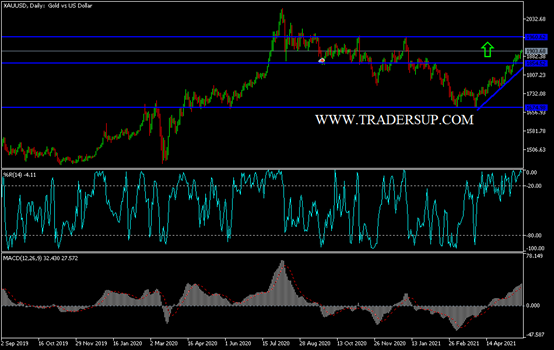We have mentioned this a lot as contained in the event that the dollar continues in its current weakness. Its gains reached the resistance level of 1907 dollars an ounce at the time of writing the top analysis for the yellow metal more than four months ago. The weak results of the recent US economic data contributed to the stabilization of the dollar's weakness, and thus the continuation of gold's gains. Yesterday, it was announced that the US Consumer Confidence Index declined to a reading of 117.2 from April's reading of 117.5, the highest level since February of 2020, just before the start of the epidemic.
The Current Situation Index, which is based on consumers' assessment of current labor and labor market conditions, rose to a reading of 144.3 from 131.9 Although the percentage of consumers surveyed claiming "good" business conditions decreased slightly from 19.4% to 18.7%, those who claim that conditions are "bad" have decreased the most, from 24.5% in April to 21.8% in May. .
Consumer evaluation of the labor market also improved as the percentage of consumers who say that jobs are "abundant" increased from 36.3% to 46.8%. And those who say jobs are hard to come by are down to 12.2% from 14.7%. Jobless claims have fallen to epidemic lows every week for the past month.
The conference board expectation index, based on consumers' short-term views of income, business and the labor market, fell to 99.1 in May from 107.9 in April.
Economists argue that increased confidence should boost overall economic growth as consumers, who account for 70% of US economic activity, spend more as lockdown restrictions loosen or abandon them altogether in many places.
Recent government data shows that the country's GDP - its total output of goods and services - is expected to continue to rise. After gaining 4.3% in the fourth quarter of 2020, the US government's first estimate for the January-March quarter came at a rapid annual rate of 6.4%. Some economists are forecasting greater growth in the current quarter from April to June - at an annual pace of 10% or more - driven by a rise in the number of people traveling, shopping, eating out and resuming spending habits before the pandemic spreads.
The US housing market grew excessively as demand outstripped supply so that prices continued to reach record levels - nearly half of all American homes are now sold above the listing price. Two years ago, before the outbreak, only a quarter of homes were selling above the price sellers were asking, and yesterday, new data shed further light on the hot nature of the housing market: prices rose in March at the fastest pace in more than seven years. The S&P CoreLogic Case-Shiller index of house prices in 20 cities jumped 13.3% that month compared to the previous year - the biggest gain since December 2013. The price hike followed a 12% year-on-year jump in February.
There are several factors driving the apparently continuing rise in home prices. As the epidemic encouraged more people to search for the extra space a single-family home could provide. However, at the same time, Covid-19 discouraged many homeowners from selling and opening their homes to potential buyers, thus reducing the number of homes for sale. Mortgage rates remain at historically low levels, with the average 30-year fixed mortgage rate around 3%. A year ago, the rate was close to 3.25%.
According to the technical analysis of gold: The price of gold will continue to interact with the level of the US dollar. The trends of global economies to reopen economic activity amid the strong pace of pollination, and the optimism of the markets will only be hindered by concern about the epidemic situation in India. With the price of gold surpassing the level of psychological resistance of 1900 dollars an ounce, investors are wondering about the next price of gold. On the daily timeframe chart, gold's gains pushed technical indicators to strong overbought levels. Profit-taking selling may be considered by moving towards 1916, 1928 and 1937 levels, respectively. After the recent gains, a downward shift affecting expectations will not occur without gold price moving below the support level of $ 1850 an ounce

